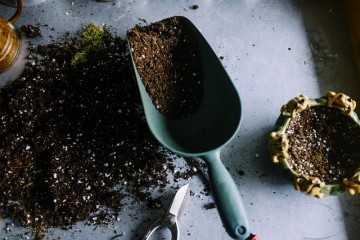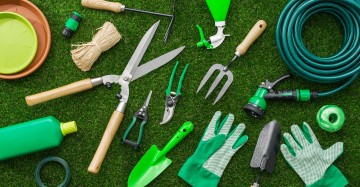Understanding Available Sun for Your Landscape
Sun is one of the most important factors in whether the plants around your home flourish or just wither. Simply put, the available sun is the amount of sunlight that areas of your landscape will get. The available sun should be the first consideration when working on the design of your garden. Well placed plants will reward your hard work and planning with beautiful blooms and foliage throughout the year.
Making a Sun Map of Your Landscape
One great way to get familiar with the amount of sun that's available in your landscape is to make a map. Grab a sheet of graph paper and draw your property. First, make a note of any features. Block out the driveway, draw the house, the garage, and any outbuildings such as sheds.
Once that's out of the way, take a step outside. Do you have any large trees making shade? Does your house cast a shadow that lasts all day? Anything that creates permanent shadow should be noted. These areas should be labeled, "full shade." Then you can start paying attention to smaller shadows that only last through the morning and evening. Those areas are known as "partial shade." Areas that receive sunlight all day should also be added to the map, particularly in areas you plan to plant in. Label these "full sun."
Sun maps are an excellent starting point when you're working on garden design. These handy guides give you an idea of what to plant and where. It's also important to understand what each of the three light levels means, and what should be planted there.
Full Sun
According to Better Homes and Gardens, full sun is considered to be an area that receives 6 or more hours of sunlight per day. In our climate, which is on the drier side, it's great to choose plants that can handle the California heat and a little less water than usual.
A general rule to keep in mind is that plants adapted to grow out in open fields already like the sun. Grasses, trees, and tall flowers are great candidates. Avoid planting woodland plants in direct sun.
A few good examples of flowers that will thrive in full sun are cosmos, coneflowers, and verbena. Each of these flowering plants love to get plenty of sunshine and are rockstars even when they're largely ignored. Flowering verbena is also a great choice if you need ground cover to fill up open spaces.
If you're looking for something less flowery and greener, you can also find quite a few plants that give great foliage in full sun. Drought-tolerant grasses like fescue and wheatgrass are great options, and you can be sure they'll handle just about any conditions the season might bring. Succulents are also great and low-maintenance options. These include much more than cacti and snake plants. Try mixing things up with an evergreen desert spoon, jade plants, monk's hood, and bottle trees.
Partial Shade
If you guessed that partial shade indicates direct sunlight during part of the day, you guessed correct! According to The Spruce, partial shade is a measurement that refers to areas that get between 3 and 6 hours of light. These light hours usually fall in the cooler hours of the day, in the morning or in the evening.
Partial shade is like the Goldilocks zone of your landscape design. Many plants need a good balance of light and shade. Placing finnickier plants in partial shade is a good happy medium. It prevents scorching without denying plants light.
These areas are usually shadowed by trees, smaller structures, or are on the East/West sides of buildings where shadows move the most. Some plants, like hydrangeas, love the dappled sun underneath trees. Partial shade plants do well getting just a few hours of direct light.
Hostas and ajuga are both great for green foliage and ground cover. You may notice these plants close to buildings, and that's because they love a bit of morning shade. Bushes and climbing vines are also ideal for partially shady areas. Look for hardy roses and clematis to best suit the local climate.
Full Shade
Shade is considered a part of the landscape that gets 3 hours or less of direct sun. Parts of your landscape that sit under any type of canopy, whether manmade or the natural canopy of trees, is shady. In these areas, it is important to avoid planting anything that needs lots of sunlight. If you place a sun-loving plant in the shade, the results will disappoint you.
Luckily, there are plenty of plants that love to hide away in the shade. As a good rule of thumb, you can look for plants that tend to grow in forests. Because they're adapted to grow under the tree canopy, they're used to softer light. Lungwort, bleeding hearts, and some lilies pack a punch of color.
Ground cover for shaded areas is also available, even in our hot temperatures. Varieties like St. Andrew's Cross, brass buttons, and Golden Creeper will thrive, particularly in well-drained soil. Try options like dianthus and Asian jasmine for pretty blossoms.
Getting to Know Your Space
Once you have a good idea of how much sun each area gets per day, you can really start cracking on your own landscape design. It's a great idea to make new sun maps of your property in the later months when the sunlight and shadows are different. Making new maps once every few years is also important. Over time, your property or light may change due to new buildings or trees nearby. Updating maps helps you keep the right plants in your gardens. It's also an awesome way to come up with new landscape design ideas and stay excited about the beauty of your property.
Summer Landscaping Tips
Our lawns and gardens are extensions of our homes. They are often the first thing visitors notice. Beautiful landscaping sends a warm, welcoming message. If your lawn and garden are looking less than desirable this summer, follow these landscaping tips to create a thriving, serene outdoor retreat.
Landscaping Maintenance
The fastest way to make your landscaping look its best is by practicing regular maintenance. Overgrown plants and trees are more than just unattractive. They can become hazards if they are growing near power lines or blocking sidewalks. Remove overgrown twigs, branches, and debris to give your landscaping an instant makeover and tidier appearance.
Don’t Let Pests be Pests
Insects and animals can have a detrimental effect on your landscape. Be proactive to prevent them from damaging your plant life. Choose a safe, organic pesticide or practice proactive garden design to keep them out. For example, plant petunias in a sunny spot to repel beetles, aphids and squash bugs. If mosquitos are driving you mad, plant basil near gathering areas to ward them off. If aphids are a problem, try planting marigolds to keep them out of your yard. To guard against worms, flies, and slugs, consider planting alliums.
The same proactive garden design ideas can be used to keep deer at bay. To stop them from feasting in your yard, add fuzzy or hairy plants to your landscape. Good options include Siberian bugloss, yarrow, and ageratum. The deer are repelled by the soft bristly hairs on these plants.
Deer and other mammals also tend to stay away from plants with fibrous, leathery or thick foliage. Plant peonies, pachysandra, and irises to create a beautiful landscape that won’t tempt your neighborhood’s wildlife.
Mow Regularly
The most important tool you have for keeping your landscape looking great is your lawnmower. Depending on the growth rate of your lawn and your preferred height, you should mow the grass at least once a week. If your grass is already high, cut it on your mower’s highest setting then reduce it as the season progresses. Avoid the temptation to cut your grass too short in an effort to mow less. Grass must be a certain height to fight off lawn hazards, and cutting it too short will prevent it from thriving.
Reduce Water Usage
Most lists of landscaping tips include advice on hydrating your lawn and garden often, but the lower precipitation in our area in recent years reminds us that our supply of fresh water is limited. That doesn’t mean your outdoor space has to go brown! There are several ways to keep your space green without regular watering. One of the best ways is to replace your grass with plants that require less water, including:
- Blue grama, a perennial native grass that is drought-tolerant and grows well in full sun
- Slender sedge, a perfect lawn substitute for light shade
- Pacific dune sage, which may be used as either a substitute for your lawn or left to grow as an unmowed meadow
- UV Verde buffalo grass, which was developed as drought- and heat-tolerant grass by the University of California
Use Mulch to Save Time and Promote Plant Health
Thoughtful landscaping tips are about more than just creating attractive outdoor spaces. Garden design is also about promoting a healthy landscape that reduces labor, controls weeds and conserves water. Using mulch is one of the best ways to achieve these goals. When you use plant trimmings as mulch, you can save time and money by significantly reducing weeds that need to be pulled or treated with expensive herbicides.
Mulch also promotes plant health by reducing competition from weeds and feeding beneficial soil organisms. By keeping the soil moist, mulch reduces the need for extra watering, and it improves soil structure by preventing soil compaction.
Before you mulch, pull weeds and water your soil. If you have grass around trees, remove it before mulching to mimic the way trees naturally grow. Keep mulch about 6 to 12 inches from tree trunks and the bases of shrubs and apply a layer of about two to four inches.
Use Color Theory for an Attractive Garden Design
Garden design encompasses many different principles, including texture, scale, form, and color. Understanding color theory is one of the best landscaping tips that will help you create a summer landscape that is pleasing to the eye.
If you’re intimidated by combining colors, choose one color you love as the basis for a monochromatic garden. Sunny yellow, pretty pink and eye-catching purple are good options because there are a variety of flowering species available in each color. To prevent your garden design from becoming boring, look for plants in different shades of your chosen color to create variety.
Use the color wheel for inspiration when combining colors. The color wheel makes it easy to understand the relationships between colors. Colors that blend well together are analogous and next to each other on the wheel. This means that planting red, orange and yellow flowers, for example, will create a pleasing look.
For a stronger contrast, plant flowers in complementary colors. These colors appear opposite from one another on the color wheel. You may plant red roses among a bed of green foliage, or yellow daisies next to purple irises.
Paying attention to color shades can also transform your garden. Dark colors can create a serene, calming atmosphere and may make your garden look larger. If you are planting in a small space, use dark shades to make the most of it.
Brighter colors draw more attention, create a festive atmosphere and may make your space look smaller. If your garden is large, you may use them to border smaller areas for gathering and entertaining.
How to Make Your Landscape Drought Tolerant
Do you envision having a beautiful lawn all year round but feel challenged due to periods of drought? Well, there is hope! With careful planning, there are a variety of choices that would make anyone think you are a landscaping genius. This may be easier on your pocket than you think.
Let's Start
Think of your yard as a blank canvas, noting where it is sunny, shady, and all areas of partial shade. Focus on the different seasonal climate, including times of rain or drought. Drainage should be considered in wet times and moisture in dry periods.
Soil condition is another consideration. Different plants like different types of soil, so identify your kind of soil and the pH level. Also, know your planting zone when choosing your plants to ensure they will be happy and thrive.
Graph out your bedding areas. Having shade beds as well as sunny ones will give variety to your landscape.
Don't forget the lawn. There are many types of grass available, so give this some thought and consideration. Good lawn questions are:
- What kind of grass looks attractive in all seasons?
- Will it survive dry periods without heavy watering?
- Will the lawn need to be reseeded often?
- Does the grass choice compliment my garden format?
Recommendations For Drought Tolerant Grass
Once again, making an all-season approach to this decision is important.
Tall Fescue, Sheep Fescue, Buffalo Grass, and Wheat Grass do well in cooler seasons while Bermuda Grass, St. Augustine Grass, Zoysia Grass, Centipede Grass, and Bahia Grass do better in warmer climates. You may want to check with a local landscaping company to know which kind of grass meets your criteria.
Decorative Mulching
Really, is there such a thing?
Think of the mulch as the skirt of your plant with the plant being the body. It does have a visual impact on your garden and it will help you conserve moisture. The things to consider when choosing your mulch are:
- Will it cut down on weeding?
- Will it hold moisture?
- Is the pH compatible?
- and does it enhance the visual appeal of my plants?
Drought Friendly Plants
The plants are the show-stoppers of your garden and they also add value to your home with good garden maintenance.
The market provides a great selection of full sun, partial sun, and shade plants that tolerate dry conditions. Reference your landscaping company to determine what types of plants will thrive in which garden area of your yard.
Color does not have to be sacrificed. You can have a vibrant wildflower garden or a flowering cactus rock bed. Spikey-leaf succulents add drama and taller grasses bring fluidity in the wind. Many of the flowers attract pollinators such as butterflies and hummingbirds. In fact, the butterfly and hummingbird bushes are among the plants that are listed for drier conditions.
Many of the plants are perennial. Check to see when each plant flowers to create stunning visual effects.
Another suggestion is to create a tiered bed using a fence as a backdrop and planting lower growing plants in the front and graduating the height. A mix of annual and perennial plants can be fun but remember to plant the annuals with easy access for cutting.
Garden Maintenance
Make it easy on yourself by considering maintenance in the planning stages. Mulching helps to keep down the job of weeding. Buried soaker hoses tend to cut down on moisture loss especially if timed to water in the early morning. Sprinkles for the lawn should also be timed for early morning or late at night, giving the water time to wet the soil before evaporation.
When mowing, use a higher setting for your blade. This will also help conserve moisture. Most grasses will have a slow growth rate in environments of high heat or dry periods so leaving the blades longer does not necessarily mean more mowing. During the dry season, try to keep foot traffic to a minimum to reduce damage to the grass.
Planting to Attract Birds and Butterflies to Your Home in Santa Cruz
If you’re planning to beautify your outdoor space, then you have the opportunity to help local birds and butterflies as well! By planting beneficial shrubs and flowers in your landscape, you can provide a sanctuary for important pollinators in your area. Doing so will make your home lively and help improve your local environment as well.
If you’re interested in a bird and butterfly friendly landscape design, then check out these landscape design ideas for attracting birds and butterflies to your home in Santa Cruz.
Focus on planting what birds and butterflies want to eat.
In order to attract butterflies and birds to your yard, you’ll need to provide them with the foods they like. Nectar, berries, seeds, and edible insects are all on the menu for many species of birds, so look for plants that will provide them.
Pollinator plants are a must-have for your garden since many of them appeal to butterflies and hummingbirds alike. To attract hummingbirds, in particular, plant native flowers that are red, since they’re more visible. You’ll want to group plants together in large patches of color when possible to make them easier to spot from above.
Additionally, make sure you keep some older natural features, such as tree stumps or logs, while you’re planting new things. These provide a breeding ground for grubs and insects that many birds find appetizing.
Plant for all life cycles and seasons.
The more variety you can include in your garden, the more birds and butterflies you’ll attract! A good place to start is to include both annual and perennial plants around your home so that you’ll see changes throughout the year. This will ensure that wildlife will have something beneficial all year-round.
Another important thing to consider is the butterfly’s life cycle. Alongside the flowering plants that attract adult butterflies, include plants that provide food for caterpillars as well. Grouping plants together by type will also make it easier for caterpillars and butterflies to thrive in your garden.
Plan your irrigation system carefully.
Flowers and nectar are key when it comes to attracting birds and butterflies to your home, and plants require plenty of water in order to bloom. When dry weather strikes, plants are less likely to bloom since they’re busy conserving water in their stems and leaves instead.
Opting for a drip irrigation system is a great move, as is covering that irrigation system with a good mulch that will slow the evaporation rate. This will ensure that your plants absorb as much of the water as possible, rather than losing it to the dry air. Just take care to leave other areas of soil around your home exposed, so that native insects can complete their full life cycles.
Shop locally for your bird and butterfly garden.
If you aren’t sure which plants will do best in the Santa Cruz area, you might want to consult with local environmental groups or plant nurseries. They’ll be able to suggest which plants to arrange adjacent to one another based on soil, water, and light requirements--and they’ll probably be able to give you tips on which plants to choose if you want something easy.
To get you started, here are some commonly planted species that thrive locally and attract birds and butterflies:
- Milkweed varieties
- Low Blue Blossom
- Hummingbird Sage
- Dogwood
- Black-eyed Susans
- Wild Bergamot
- Mexican Elderberry
- Hollyleaf Cherry
Include water features and natural debris to attract more.
Alongside a wide variety of plants that provide both food and shelter for local birds and butterflies, you’ll want to include other attractive features as well. One of the best things you can add to your garden is a water feature, especially a fountain that makes an audible splash.
You might also want to consider letting a moderate amount of natural plant debris such as twigs and leaves accumulate. It might sound odd but consider making fallen tree branches or piles of twigs a part of your landscape design! Instead of raking them away, leave them in convenient places so that birds can use them for nesting materials.
It’s also a great idea to decorate around your water feature or garden pathway with pebbles and rocks for butterflies to sun themselves on. Creating a couple of pebble-lined depressions in the soil for shallow puddles to accumulate will allow butterflies to drink easily, too.
Include some pre-made shelter in your landscape design.
While loose debris is certainly handy for harboring insects and providing birds with nesting materials, you might want to go a step further. By putting up some bird boxes, you’ll increase the likelihood of local birds feeling secure and comfortable enough to stay.
To make it even more appealing for birds to set up shop around your home, hang up some bird feeders nearby as well. You can attract a wider variety of birds by installing several feeders with different types of bird feed around your garden.
Avoid pesticides whenever possible.
While many people shudder to think of pests devastating their garden, pesticides should be used with extreme caution (if at all). You don’t want unnecessary or incorrectly applied pesticides to harm the very pollinators you’ve worked so hard to attract!
If you need to use pesticides to protect your garden, then seek out pesticides that precisely target the pests at hand. Pay close attention to the instructions and apply as carefully as possible to avoid collateral damage.
Keep pest control in mind from the very beginning, and avoid buying plants grown with neonicotinoids. These pesticides make their way into the plant itself while it grows, poisoning insects indiscriminately. Unfortunately, that means that beneficial insects will also be harmed if they come into contact with neonicotinoid-laced plants.
To Recap:
When planting around your home to attract birds and butterflies, keep their ideal diets and other needs in mind. Make sure you include a good variety of flowers, fruit shrubs, and insect habitats in your butterfly and bird sanctuary.
Aim to plant primarily native species in your garden and take some advice from local environmental groups and plant nurseries regarding how to arrange them. You’ll be able to keep the wildlife coming year-round with a nice intermingling of annual and perennial plants in your landscape.
To top everything off, add a nice, trickling water feature to let birds know that you’ve provided them with an oasis. Make sure you’re irrigating efficiently and using pesticides as sparingly and cautiously as possible. Mulch around your soaker hoses to prevent unwanted evaporation but be sure to leave some bare patches of soil so that insects can thrive!
Natural Methods for Managing Pests
Whether you are a complete beginner or have been gardening for a few years, you’re bound to deal with pests. It is true that there are pesticides for these insects that destroy your plants. However, they contain harsh chemical compounds that can be harmful to the environment. You also have to worry about their safety if you have kids around.
The good news is that there are natural and inexpensive ways to combat these unwanted insects.
The First Defense Against Destructive Insects
You cannot always be in your garden getting rid of bugs. Thankfully, there are insects that help eliminate those that you want out of the yard. For instance, there are ladybugs that aid in removing soft-bodied insects, such as aphids. Braconid wasps lay their eggs on other insects. When they start to hatch, they eat the host before they move on to the next stage of their life cycle.
The best way to attract these beneficial bugs is to provide food for them. Pollen, nectar, and sometimes seeds can be inviting to these insects. Therefore, you should plant some flowering plants and offer the bugs with good water source as well.
Top Garden Pests and What to Do with Them
From tiny invaders to those that are easy to spot, you can keep them out with natural methods. These techniques will help avoid eliminating unintended species. Plus, chemicals will not leach into the soil and water.
Defending your garden should start with the identification of the insects that attack your plants. When you can identify the bugs, you will also know what to do. Here are the most common insects and how you can control them:
Ants
These insects are everywhere, from your home to your garden. You may have to kill the queen to eradicate them. The following are proven methods that work:
Slice bitter cucumbers or use the peels around the plants. Ants naturally detest the smell of cucumbers, which will make them stay away.
Leave mint tea bags where the ants often go. If unavailable, go for dried mint leaves.
Slice garlic cloves and spread all over your garden.
Cayenne pepper, lemon juice, and coffee grounds will also work as natural ant repellents.
Aphids
You do not have to be a long-time gardener to recognize these pesky critters. Aphids are usually all over fruits and veggies but you can also find them on flowers and even shade trees. They are problematic because they eat plant sap. As a result, you will notice deformed foliage and plants lose their leaves quickly.
Aphids’ excretions stay on the leaves, supporting mold growth. As these insects feed, they spread viral diseases. Control them immediately through these methods:
- Use strong water spray to wash the plants.
- Invite beneficial insects, such as lady beetles and lacewings, to prey on the aphids.
- Use natural repellents, such as garlic and hot pepper.
When the problem is severe, you can choose neem oil as your organic insecticide.
Cabbage Maggots
If you have cabbage-family crops and other cruciferous vegetables, you could deal with these maggots. They burrow in the ground, going directly for the roots. Therefore, they end up killing the plant directly. In some cases, they invite other organisms, which lead to plant diseases. Destroy these creatures with the following tips:
- Cover the plants or grow them in row covers to prevent infestation.
- Remove dead vegetation but do not compost the plants. It will lower the areas where maggots deposit their eggs.
- Till the bed as deeply as you can before the fall season ends. This method exposes and eliminates maggot pupae, which may be living in the soil.
Neem oil can also be effective in ridding these pests.
Caterpillars
These insects may turn into beautiful butterflies, but they can be damaging to your garden. They chew the leaves and tunnel into fruits. Deter them by encouraging the existence of native predators. You should also handpick your harvest and if possible, use floating row covers.
Beetles
Different types of beetles can visit your garden from time to time. Most of them can be destructive when uncontrolled. Flea beetles, for example, hang out on vegetable crops. These insects are common all over North America, including the Central Coast. Adult flea beetles destroy the leaves of the plants, creating round holes. Meanwhile, larvae feed on the roots.
An effective way for you to control these beetles is by creating garlic spray. Kaolin clay also works in keeping them away from your plants.
Other Tips to Ensure an Infestation-Free Garden
It is not always possible for you to eliminate all the pests from your yard. However, the following can help keep damaging insects to a minimum:
- Landscaping: Steer insects away from the garden with a smart landscape. Get rid of weeds, make sure you care for your lawn and start mulching. If you have decorative pools and bird baths, clean them often to remove standing water.
- Native plants: Trees, bushes, and other plants that are native to California. Some examples include coast live oak, incense cedar, and sweet acacia. They have well-adapted to the local soil, as well as the climate conditions in the area. Therefore, they can mostly handle attacks from indigenous insects.
- Diversity: Monoculture agriculture tends to use a great number of pesticides. Just one particular insect species can be disastrous for the whole crop. With permaculture gardens, you have different plant varieties. If one crop suffers and dies due to infestation, the others can still survive.
- Healthy soil: The reason why plants thrive is the soil. If it is healthy, the plants become more robust as well. Build a fertile soil so the crops can withstand insect attacks. Limit soil turning to prevent erosion, compaction, and runoff. Let nature take over with the help of earthworms that will aerate the soil for you.The hard truth is that all gardens will have their fair share of pests. Even if you have healthy soil and there are beneficial bugs around, there will still be problems. Continuously monitoring your garden to stop damage before it gets worse is the key to a sturdy and thriving landscape.
How and When to Water your Garden
You may think that watering your garden seems like a no-brainer, right? You turn a nozzle and water comes out. Wrong! Keeping your flowers and plants properly watered actually takes a little insight if you want to make sure it’s done properly.
Veggies need water to grow and flowers need it to thrive. Overwatering, under-watering or even watering at the wrong time of day can put your precious plants at risk of things like rot, wilting and not growing at their full potential.
Poor Watering Habits
Poor watering can not only destroy your veggies and flowers, but it can also be detrimental in places where there is a drought or water limitations. Water is a highly precious resource and it’s important to be knowledgeable about watering your plants. With just a little knowledge, you can become a watering expert and make sure you have a landscape with stunning flower beds and ripe, thriving veggies and herbs.
Dos and Don’ts of Properly Watering Your Garden
- Do water as early as possible in the morning when the ground is the coolest and the plants can best soak up the water.
- Don’t water during the middle of the day when sunlight is beaming down. This is a recipe for your plants to wither up and die.
- Don’t water late in the evening after the ground has been baking in the sun all day. Without the chance to dry, your plants will be prone to attracting bugs and rotting.
- Don’t water for too long. You are most likely simply wasting water and it will be more likely for your veggies to have fungus and for your flower beds to become soggy.
- Do water thoroughly enough for the water to soak into the roots. The roots are what really need nutrients.
- Do give your lawn at least one inch of water during the driest, hottest months of the year. A great landscape will be the perfect complement to a lovely garden.
- Do aim the water hose at the base of the plants. Your goal should be to thoroughly moisten the roots instead of soaking the flowers and veggies. Wet foliage can leave to fungus growing.
- Don’t water haphazardly when you only have a few minutes. Your goal should be a thorough moistening. One of the worst things you can do is to give the plants a quick hose during your lunch break or after work.
- Do give all newly planted flowers and veggies a thorough soaking immediately after planting them or their seeds.
- Don’t use a hard-blasting hose setting or a hose that has a very wide spray. These will likely damage the plants and don’t always reach the roots.
- Do invest in a gentle water wand. This is especially good for flower beds that love a gentle sprinkling rather than a hose blast.
- Do utilize mulch and compost when possible or work with a professional landscaper. This helps the soil to rain the moisture.
- Don’t overwater during the dry months. This can cause the vegetables and fruit to rapidly inflate and the skin will end up splitting open and attracting bugs.
- Do avoid getting the leaves too wet if you can, especially if they are in direct sunlight. This literally causes the leaves to bake in the sun.
- Don’t rely solely on a sprinkler to get the job done. Sprinklers are for lawns. A great garden needs a loving gardener to take the time to water it properly.
Watering Frequency
Some of the most common questions are regarding the frequency of watering. You should typically be watering two to three times each week unless you live in a place with excess rain. This is the proper watering volume for the warmer spring and summer months. Fall months will likely need less water. When you water, make sure the water has the chance to really soak into the soil. You want to make sure it reaches the roots that need water as a nutrient.
Watering Container Gardens
If you have flowers or veggies planted in containers, you will typically want to water them every day during the warmest months. Container gardens tend to hold moisture more than general gardens do. You will want to push back the soil to make sure there aren’t soggy puddles that will lead your container gardens to become overwatered. Again, you want to give them about an inch of water.
Watering Tools
This is when a watering wand comes in exceptionally handy. A watering wand is a very gentle spray. It is almost close to mist. This allows you to put a shallow cup or small bowl in the garden so you can measure to make sure it is receiving about one inch of water each time you spray. If you don’t want a watering wand, make sure that you always set your hose on the “shower” setting. One of the biggest mistakes people make is blasting their veggies and flowers with water. This is basically a shock to the plants and it often doesn’t allow the water to sink all the way down to the roots where it is most needed.
Reinvigorating Your Landscape During Spring
Rain and moderate temperatures create a wonderful atmosphere and healthy soil conditions for spring landscape projects. Before your perennial plants begin to emerge, get outside and enjoy some sunshine and exercise while tackling yard and garden maintenance.
Yard Cleanup and Weed Control
Although you might have the best intentions to clean up debris and weeds from the yard during the fall, football games, kids’ sports, and school activities often take precedence.
In the Spring, you can’t put it off any longer and you need rake up old leaves before your flower beds begin to sprout. It is also important to get rid of wet plant debris and twigs from your yard landscape to prevent mold from forming.
If you have been working on your compost pile, mix up the soil and transfer it into your vegetable or flower garden. As the temperatures begin to warm up, the soil will combine with the dirt in your beds and enrich and fertilize your Spring plants.
This is also the perfect time to spread some pre-emergence weed control in your rock gardens, along sidewalks and patios, or anywhere you don’t want weeds to grow.
Revamp Landscape Design
Last year you might have noticed the beautiful landscape and gardens in the yards around your neighborhood. Spring is the perfect time to look at your own landscape design and make some changes and improvements.
You can call in landscaping companies or try some ideas on your own. If you are thinking ahead to conserving water, consider creating flower beds with California native plants.
You can find options to plant along your walkway, as a border, or to attract birds and butterflies. You should also consider taking out older bushes or plants that did not do well last summer. Planning out a design in advance will help you create amazing curb appeal.
To Prune or Not to Prune
Spring is also the best time to prune many shrubs in your yard. First look around and remove any branches that are dead or broken. If you have Hydrangea and butterfly bushes in your yard – these can also be pruned to encourage healthy new growth.
Late spring is also the time to give your rose garden some attention. Depending on the variety of roses, you should remove about a quarter to a third of the plant to stimulate new foliage and fragrant flowers throughout the summer. Some plants in your landscape should not be pruned until after they flower. These include Azaleas, Mountain Laurel, and Rhododendron.
Caring for Fruit Trees
If fruit trees are part of your landscape, Spring is the time of year you need to fertilize to ensure a great crop. Many of these trees bloom in Spring and begin preparations for producing fruit. You might need to include some extra watering if your trees are new and be sure to remove any broken branches.
Another great way to conserve water throughout the summer is to add mulch around the bottom of your trees. Create a rock or paving stone border to keep the mulch from spreading out and your fruit trees should flourish throughout the season.
Renew Ornamental Grasses
Ornamental grasses are a great way to add height and structure to your landscape. You probably leave the foliage during the winter to add some interest to your yard, but in the spring, you need to cut back before the plant wakes up and begins growing. Cut the old growth off about six inches from the ground. If you are environmentally conscious, consider planting deer grass instead of pampas grass which can become invasive. You will also want to cut back Liriope to create and maintain your borders and give your landscape a fresh look for spring.
Add Color to your Spring Gardening
If you enjoy lots of colors all throughout the Spring and Summer months, now is the time to think about adding some new flowers to your landscape. There is a large variety of drought-tolerant flowers that will look beautiful without a lot of water and care.
Plan out your color scheme to coordinate with the color of your home and other plants in your yard. Once you have decided on the colors, think about height and texture and then find flowers to fit your needs.
Consider adding some herbs or vegetables that will add interest to your yard. Landscaping companies will often help build and design raised beds, interesting fountains, and rock features to create a unique, attractive and easy maintenance appearance to your yard.
As you begin to look forward to the summer months and entertaining friends and family in your outdoor spaces, make sure your yard looks amazing by following our Spring maintenance suggestions. Not only will your plants be happier, but your neighbors will also be jealous of your beautiful flowers and shrubs and your unique garden decor.
How to Grow a Fruitful Garden
Have you always wanted to start your own home garden? Don’t let intimidation hold you back. Although it takes time to develop a green thumb, starting a garden is easier than you think. You simply need to break the process down into basic steps. They include the following:
Choose What You’ll Grow
You want your garden to eventually yield crops you’ll actually use. Thus, it’s important to consider what types of fruits, vegetables, and herbs you enjoy the most when choosing what to plant.
It’s also smart to talk with experts at your local gardening center to find out which crops they recommend for beginners in your region. You want to start with something easy before advancing to more difficult crops.
Choose the Right Location
The next step in starting a garden involves researching what types of environments are best for your chosen crops. For instance, some crops require regular exposure to direct sunlight, while others don’t.
Knowing what environment your crops thrive in is key to knowing where to plant them. Additionally, you should consider how accessible the garden will be. A garden that’s in an awkward spot to reach on your property, or in a spot where it’s relatively out of sight, may get neglected. Place it somewhere you know you’ll pay attention to it.
Plan Garden Beds
The space you have to work with will play a role in determining how you’re able to organize your garden beds. If you have limited space, you might want to arrange them vertically to maximize your usage of it.
It’s also a good idea to arrange beds in blocks. Individual rows aren’t always easy to tend to and can take up more space than beds.
Make sure the beds are no longer than four feet wide (you want to be able to reach every part of them when tending your crops) and 10 feet long. You can also consider adding companion plants to maximize the health of your crops.
Additionally, if you’re planning on planting climbing crops, like green beans or tomatoes, you will need to put stakes into the ground. You can easily make your own by cutting scrap wood with oscillating saw blades or an electric chainsaw, depending on the size of the job.
Get the Right Supplies
Speak with the experts at your local garden center to determine which supplies you’ll need to grow your crops. Explain to them how you plan to arrange your beds to get more accurate recommendations. Basic supplies you’ll likely need include dirt and leaf rakes, gloves, a lightweight wheelbarrow, garden and scuffle hoes, and a proper garden shovel.
Prep the Soil
The condition of your garden’s soil plays a major role in the potential growth of your crops. Luckily, there are many kits you can use to test it. Although most crops thrive when the soil has a relatively neutral pH of seven, it’s important to research your crops beforehand to confirm this. Some may thrive better in slightly more acidic or alkaline environments. Make any adjustments necessary based on the results of your test.
You should also research the types of organic matter that will provide your crops with the best nutrients. Add them when building the soil in the garden bed to boost its fertility.
Plant & Tend
The crops you buy will likely come with instructions for planting them. Follow these carefully to ensure the best results.
They’ll also likely explain how to tend to your crops. You may want to ask your garden center expert for any extra trips. Again, follow the advice carefully to maximize your harvest. Consider setting a schedule ahead of time so you’re more likely to stick to it.
The first garden you create will be an experiment. You’re learning a complicated process. Luckily, following these steps will help you achieve quality results the first time around. As you get more comfortable with gardening in general, you can experiment with other crops, bed designs, and more!
Maintaining Your Garden: The Efficient Way
Maintaining a garden requires dedication and a plan. This doesn’t mean you have to spend hours cultivating soil or anxiously stay up all night waiting for seedlings to blossom. Instead, you’ll want to take an efficient approach to your garden maintenance. This will allow you to have a flourishing flower bed without the hassle. Whether you are returning to a flower bed that you grew last season or are starting fresh, you’ll want to activate these helpful tips:
Get Your Soil Prepped
Successful gardening really comes down to the quality of the soil. Without nutrient-rich dirt, there won’t be a lot that has a chance to grow. Starting a fresh garden will require a certain amount of soil prep. That begins with turning that soil over. This might be the most labor-intensive aspect of your landscaping but the effort you apply with your soil prep can last you through the season.
Once the soil has been turned over, it is time to “feed it.” There are many soil testing kits available that can show you just what is lacking in your soil. Armed with that information, you can make the decision of which nutrients to add through the use of topsoil mixtures or fertilizer. Keep in mind that this soil feeding should happen a few weeks before you start planting. You want to give the soil the chance to acclimate.
Draw Up a Garden Design
While you’re waiting for the soil to “cook,” you can start thinking about what kind of flowers you’d like to grow. California has the kind of weather that plants love. The following is a list of flowers that flourish in SoCal:
• Lilacs
• Poppies
• Salvia
• Morning Glory
• Penstemon
• Wildflowers
• Rose Buckwheat
• Daisies
The choice now becomes do you want to grow these plants from seeds, seedlings or have them already blooming? Growing plants from homegrown seeds will certainly provide you with a sense of accomplishment but blooming plants are much more low maintenance.
You can draft a “floorplan” for your flowerbeds to visualize how your garden décor will come in. You can also adopt a wild approach by mixing and matching the flowers. That works especially great with patches of wildflowers.
Be Consistent with Watering
Watering is where you have to be the most diligent and consistent. For flowering beds to thrive, they need to be kept moist without being over saturated. One to two times a week should be enough to accomplish that moisture goal. Timing is also crucial when it comes to watering. You should aim for early in the morning or later in the evening after the sun has set. When water goes into cool soil, there is less of a chance of evaporation.
If you plan on going on vacation, then you might want to ask for help to keep your flowers watered. Of course, having an irrigation system installed will ensure that you will always be on schedule.
Tackle Weeds Head On
Weeds are the enemy of every gardener. It might seem like you’re fighting a never-ending battle with those weeds. Every time you pluck one, another pops up the next day. Can you blame them? After all, you’ve created a wonderful environment with rich soil and plenty of water.
The best way to keep weeds out of your flower beds is to stop them from growing in the first place. That can be taken care of by cultivating healthy plants and growing a dense garden. Don’t give those weeds any “elbow room.”
Another good way to keep the weeds at bay is with mulch. Spreading a layer of mulch around your flower beds not only looks great but it helps maintain the moisture content of the soil.
Watch Out for Pests
Your flowers are going to attract a lot of visitors. Some of these visitors will be welcomed while others will just be classified as pests. Not all flying and crawling bugs are going to destroy your plants. There could be a lot that are combating other pests. There is also the whole issue of pollination to count on. Yes, bees should always be welcomed!
If pests start to become a problem, then there are many homemade remedies you can try that won’t be loaded with chemicals or harm the plants.
Edit When Necessary
As your garden grows, you might find that you’re experiencing too much of a good thing. That is time to step in and do some flower editing. You can transplant some of those flowers to other areas of the yard or put them into a pot for a gift. You don’t ever want to have the sense that your flowers are crowding each other out.
Finally, when all the work is done, you’ll be able to sit back and enjoy your efforts. Just be sure to take plenty of pictures to show off to everyone. Happy gardening!










